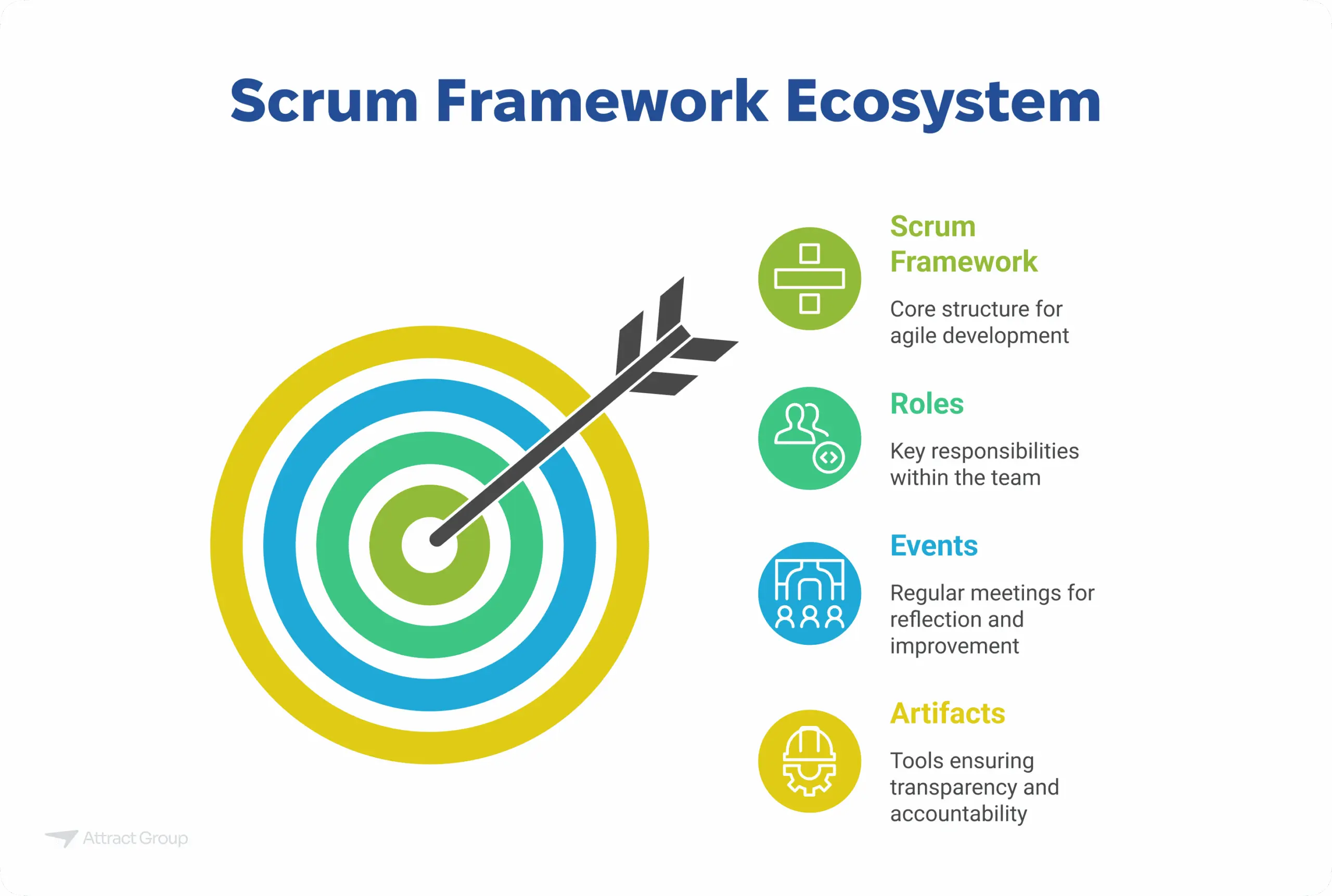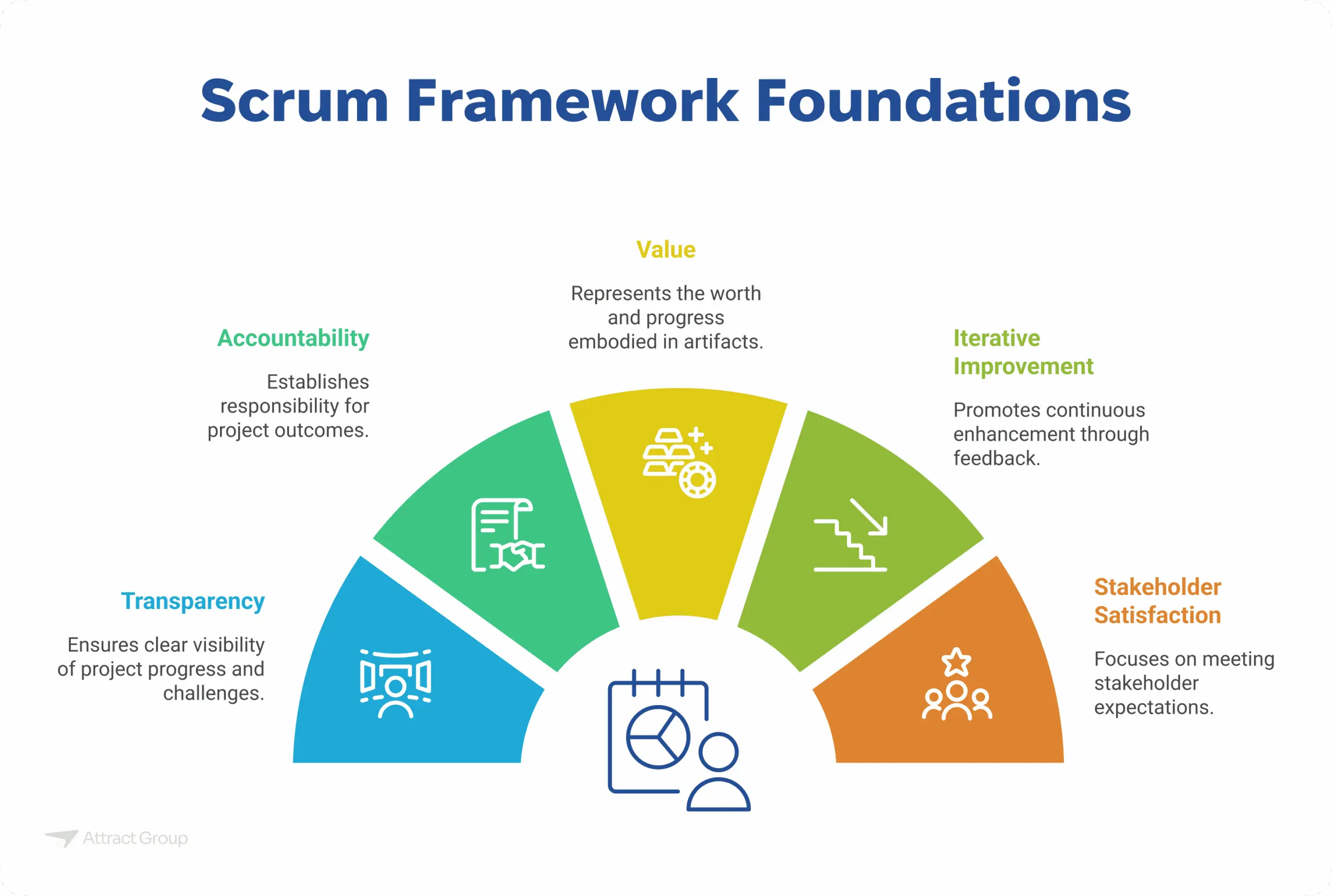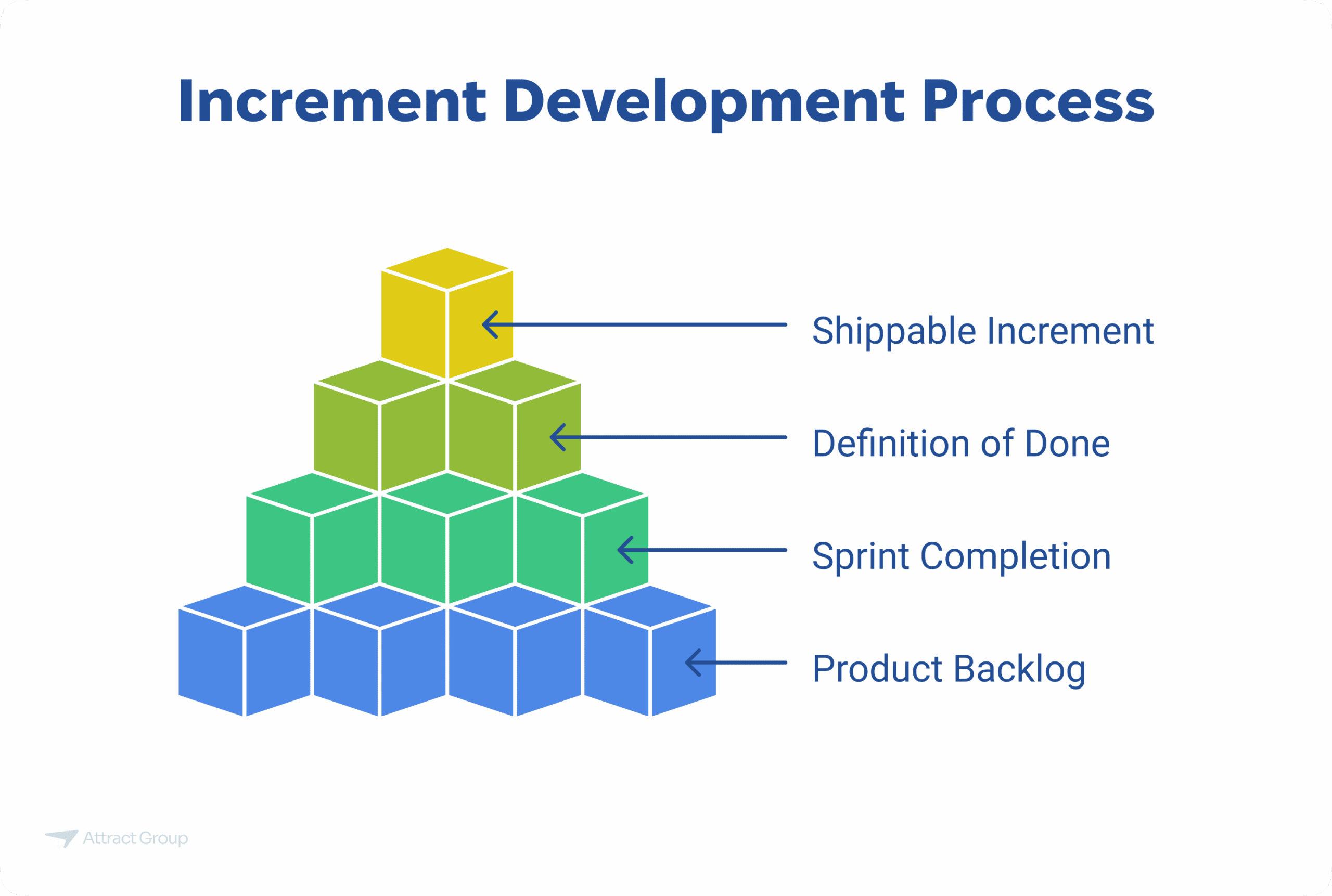Understanding the Scrum Framework: Roles, Events, and Artifacts
 10 April 2024
10 April 2024? Listen to the Summary of this article in Audio
The realm of product and software development is perpetually evolving, and mastering the art of collaboration and efficiency in these complex projects demands a robust and flexible approach. Enter the Scrum Framework, a paradigm designed to foster team cooperation and streamline the process of bringing high-valued products to fruition. Embracing roles in the Scrum framework, Scrum framework main events, and Scrum framework artifacts, businesses can harness the power of agile methodologies to deliver innovative solutions effectively and expediently.
At the heart of this framework lie the distinct roles in the Scrum framework — the Product Owner, Scrum Master, and Development Team — each with clear responsibilities and an unyielding commitment to the team’s shared objectives. The process is further defined by a series of prescriptive Scrum framework main events that guide the team through regular reflection and continuous improvement cycles. Moreover, the strategically designed Scrum framework artifacts act not only as beacons of progress but also as tools that ensure the utmost transparency and accountability in the process.
By meticulously integrating these components, the Scrum Framework promotes a balanced ecosystem where strategic planning, open communication, and dynamic response to change are not only encouraged but are imperative to success. This article aims to demystify the Scrum Framework’s intricacies and offer a clear path forward for organizations striving for agility and excellence in their product development endeavors.

Key Takeaways
- The Scrum Framework is a lighthouse for teams navigating the complexities of product and software development.
- Clear-cut scrum framework roles delineate responsibilities and foster a productive and united team environment.
- Regular scrum framework main events are the pulse of the project, maintaining rhythm and direction.
- Scrum framework artifacts act as the tangible evidence of progress and facilitate data-driven decision-making.
- By integrating roles, events, and artifacts, the Scrum Framework lays the foundation for a culture of continuous improvement and collaboration.
- Adaptability and customer-focus remain at the core of the framework, enabling teams to meet and exceed evolving project demands.
Introduction to the Scrum Framework
The Scrum Framework, a cornerstone of agile product development, revolutionized the industry with its introduction in the early 1990s. By championing the principles of Transparency, Inspection, and Adaptation, it carved a new path for teams thirsty for efficiency and adaptability. Initially intimidating, yet profoundly simple upon closer examination, the Scrum Framework empowers teams to optimize processes and deliver value through its well-architected roles, events, and artifacts.
The Pillars of Scrum: Transparency, Inspection, and Adaptation
Transparency within the framework demands an honest and open communication channel, where progress and impediments are not masked but openly shared among team members. The product owner role in Scrum framework embodies this transparency, serving as an integral linchpin that holds the customer’s interest at heart, and ensures that every backlog item reflects the voice of the customer. Inspection within Scrum is not an exercise in fault-finding but a constructive process allowing for regular monitoring of the team’s output against set goals. Finally, Adaptation in the Scrum framework is the team’s agility in response to feedback, taking decisive actions to steer the project toward the collective vision.
The Scrum framework main events — Sprint Planning, Daily Scrum, Sprint Review, and Sprint Retrospective — serve as the heartbeat of any Scrum project. These events create a rhythm, fostering a culture where continuous improvement becomes a way of life, not just a scheduled activity. The following table aligns the Scrum roles with their corresponding responsibilities and main events, clarifying their interconnectedness and importance within the Scrum ecosystem.
| Scrum Role | Main Responsibilities | Main Events Participation |
|---|---|---|
| Product Owner | Product vision alignment, Maximizing product value, Managing the Product Backlog | Sprint Planning, Sprint Review |
| Scrum Master | Facilitating Scrum practices, Coaching the team, Removing impediments | All Scrum Events |
| Development Team | Delivering potentially shippable product increments, Self-organizing to achieve the Sprint Goal | Sprint Planning, Daily Scrum, Sprint Review, Sprint Retrospective |
In conclusion, the simplistic yet profoundly effective structure of Scrum framework is a beacon for organizations striving towards excellence in a competitive marketplace. It is the growth-oriented mindset encouraged by the Scrum pillars — balancing the roles and their active engagement in Scrum events — that underlines the true value of Scrum for agile success.
Struggling with complex development projects? Our certified project managers can guide your initiatives to success.
Core Roles in the Scrum Framework
The Scrum framework is renowned for its distinctive approach to project management, particularly in the realm of software development. Central to this approach are the roles that define the responsibilities and activities within the Scrum team. These roles facilitate a cooperative and efficient environment necessary for agile success, ensuring that each member’s contribution is integral to the project’s progression. Understanding what are the roles in the Scrum framework is essential for aspiring Scrum practitioners and organizations wishing to implement Scrum methodologies.
The Role of the Scrum Master: Facilitating Agile Success
The Scrum Master stands as a lynchpin in facilitating the success of the agile process within Scrum projects. This role involves coaching the development team, removing barriers that impede progress, and ensuring that Scrum practices are followed effectively. The Scrum Master is a servant leader whose primary aim is to enhance the team’s performance and productivity within the Scrum framework.
The Product Owner Role: Voice of the Customer in Scrum
As the voice of the customer, the Product Owner holds a critical role in translating customer needs into the team’s workflow. This individual is responsible for backlog management, prioritizing tasks based on value delivery, and defining the product vision. They maintain clarity and understanding of the project’s goals, thereby aligning the Scrum team’s efforts with customer demands and organizational objectives.

The Development Team: Collaborative and Self-Organizing Experts
The Scrum framework harnesses the collaborative energy of cross-functional Development Teams. These self-organizing experts are tasked with the hands-on creation of the product increment. Their responsibilities extend to sprint planning, adhering to the defined “Definition of Done,” and maintaining a high standard of work and accountability. It’s the collective proficiency of the Development Team that propels the project forward through each sprint.
To shed further light on scrum framework roles, the following table delineates the specific functions and interactions of the core Scrum roles.
| Scrum Role | Key Functions | Interaction with Scrum Events |
|---|---|---|
| Scrum Master | Ensures adherence to Scrum practices, offers guidance, removes impediments | Facilitates and attends all core Scrum events |
| Product Owner | Manages the Product Backlog, prioritizes tasks, ensures project vision alignment | Involved in Sprint Planning and Sprint Review to provide insights and receive feedback |
| Development Team | Executes tasks to create product increments, self-manages to meet Sprint Goal | Active participants in Sprint Planning, Daily Scrums, Sprint Reviews, and Sprint Retrospectives |
The Scrum Team operates as a unified entity with no internal hierarchy, fostering a culture where open communication, respect, and collective responsibility are paramount. Mastery over scrum framework roles not only enhances individual performance but enables the whole team to respond to change swiftly and deliver products that truly resonate with users’ needs.
Main Events Defined by the Scrum Framework
Within the agile methodology of the Scrum Framework, there lies a blueprint for organizational efficiency and responsive development — it’s structured upon key events that synchronize team efforts and enhance project progression. These structured events are fundamental to the Scrum process, offering teams clear-cut times to collaborate, reflect, and adapt their strategies for the next cycle. Herein, we delve into which ones of the following main events are defined by the Scrum framework and their significant roles in driving success and adaptation.
Sprint Planning: Laying the Foundation for Success
Sprint Planning is the inaugural event of the Scrum sequence, establishing the agenda for the entire Sprint. As one of the Scrum framework main events, it convenes the full Scrum Team for collaborative decision-making on what the sprint will achieve and how the work will be tackled. This planning phase is pivotal for aligning the team’s objectives, shaping the Sprint Backlog, and fortifying commitment to the Sprint Goal.
Daily Scrum: Keeping the Team Aligned and Focused
The Daily Scrum is a catalyst for maintaining momentum and clarity throughout the sprint. This concise daily convergence is designed for the Development Team to synchronize activities and highlight any obstacles encountered. As a principal event defined by the Scrum framework, it aids in preserving team alignment on sprint goals and fostering an environment conducive to daily incremental progression.
Sprint Review: Inspecting the Increment and Adapting the Product Backlog
Following the intense effort of a sprint, the Sprint Review offers a stage for inspection and adaptation. In this showcase event, the work done is presented to stakeholders to garner valuable feedback. Adjustments to the Product Backlog can be made to mirror these insights. This meeting is a strategic rally point, ensuring that the team’s output aligns with what is most beneficial for end-users and the product’s long-term vision.
Sprint Retrospective: Continuous Improvement for the Scrum Team
The Sprint Retrospective closes the sprint and it’s where the team collectively reflects on their performance. This essential Scrum event facilitates a frank evaluation of practices, processes, and interactions. It is a dedicated time for the Scrum Team to formulate action plans for improvements, reaffirming Scrum’s commitment to fostering an ever-evolving, learning, and optimizing workspace.
Understanding Scrum’s structure-highlighting scrum framework main events — demystifies the iterative cycle that enables teams to operate with heightened efficiency and adaptability. Each event is a step in a continuous loop, propelling the team toward achieving excellence in creating exceptional products that meet and exceed user expectations.
Artifacts of the Scrum Framework: Ensuring Transparency and Accountability
At the cornerstone of the Scrum framework, artifacts scrum serve as critical linchpins that ensure robust transparency and accountability throughout the product development lifecycle. Each artifact, endowed with a unique focus and purpose, guides the Scrum Team towards achieving their goals while providing stakeholders with a transparent view of the project’s progress and challenges.
Scrum artifacts are more than mere documents; they are repositories of value and progress that embody the very essence of Scrum’s empirical approach to project management. With the proper understanding and management of these artifacts, teams are well-equipped to navigate through the complexities of product development, adhering to the Scrum principles of iterative improvement and stakeholder satisfaction.

The Product Backlog: Prioritizing Value and Flexibility
The Product Backlog stands as a dynamic testament to the project’s vision and market requirements, meticulously curated and managed by the Product Owner. This continually evolving list not only delineates the work items but also arranges them in a hierarchy of importance, a reflection of their value to the customer and their impact on the project’s success.
In its essence, the Product Backlog is a live document, one that breathes and adapts as market trends shift and project scopes evolve. It’s the strategic foresight and proactive management of this artifact that endow Scrum teams with the flexibility to pivot and the capacity to deliver products that resonate deeply with users.
The Sprint Backlog: A Plan for the Sprint
Derived from the broader ambitions of the Product Backlog, the Sprint Backlog represents the commitment of the Scrum Team to the forthcoming Sprint. It’s a detailed plan that encapsulates both the what and the how of the sprint’s objectives, framing a clear pathway for the team to follow toward their immediate goals.
It embodies teamwork and collaboration, as Developer Team members come together to break down user stories into actionable tasks, ensuring every aspect of the project’s progression is grounded in consensus and collective responsibility. The Sprint Backlog is, therefore, not just a plan, but a compact that harmonizes the team’s efforts and direction.
The Increment: Delivering a Potentially Shippable Product
The Increment is the culmination point of a Sprint, encompassing all completed Product Backlog items up to that moment that meet the stringent criteria of the “Definition of Done.” This artifact is the embodiment of progress, a potentially shippable segment of the product that is ready to deliver value to the customer if deemed appropriate.

The Increment serves as a testament to the Developers’ hard work and adherence to quality standards, offering a palpable metric of the team’s performance and progress. It reinforces the Scrum value of delivering usable increments regularly, facilitating continuous feedback and the opportunity to quickly adapt to the market and customer needs.
As Scrum Teams wield these significant artifacts with finesse, they navigate the complexities of product development with a transparent and consistent approach, delivering outcomes that stand the test of market demand and stakeholders’ expectations.
The Integration of Roles, Events, and Artifacts in Scrum
The Scrum Framework presents a collaborative tapestry that weaves together distinct roles in the scrum framework, scrum framework main events, and scrum framework artifacts, enabling agile teams to navigate the complexities of product development with precision and adaptability. By intelligently segregating responsibilities, sequence of events, and tangible deliverables, Scrum creates an ecosystem where synergies are not only possible but actively encouraged.
Effective collaboration within Scrum is not serendipitous — it is a testament to the framework’s architectural prowess which stipulates the confluence of roles, their interaction in events, and the employment of artifacts to gauge and track value creation. Through this meticulous orchestration, every team member is equipped to contribute their distinct expertise optimally.
How the Scrum Framework Facilitates Collaboration and Value Creation
Aiming toward a customer-centric and quality-focused product, the Scrum Framework ensures each role, event, and artifact acts in service to the overarching goal. The seamless interplay between the Scrum team and events captures the essence of an iterative development process, striving for a high-value product delivery. The table below illustrates the relationship between Scrum roles, their attendant events, and the methodical use of Scrum artifacts.
| Scrum Role | Related Main Events | Key Artifacts Utilized |
|---|---|---|
| Product Owner | Sprint Planning, Sprint Review | Product Backlog, Sprint Backlog |
| Scrum Master | Sprint Planning, Daily Scrum, Sprint Review, Sprint Retrospective | Product Backlog, Sprint Backlog, Increment |
| Development Team | Daily Scrum, Sprint Planning, Sprint Review, Sprint Retrospective | Increment, Sprint Backlog |
The matrix above confirms that while the roles in the scrum framework may differ in responsibilities, they share the same commitment to the scrum framework main events, enabling a harmonious union in meeting the Sprint Goals. Moreover, each role’s utilization of scrum framework artifacts upholds the principle of transparent communication and offers a visual measure of progress and quality.
In essence, the Scrum Framework advocates for a dynamic and interactive development space where the management of complexity is not a burden but an opportunity for growth. It equips teams with the autonomy to self-organize, while challenging them to constantly refine and redefine their strategies for delivering innovations that resonate with both the market and the individuals those products ultimately serve.
Addressing Common Misconceptions and Challenges in Implementing Scrum
Implementing the Scrum framework within an organization can often come with a set of misconceptions and challenges that stem from a fundamental misunderstanding of its principles and practices. Addressing these effectively is crucial to harnessing the full potential of roles in the Scrum framework and executing Scrum framework main events in a manner that drives agile success.
The Scrum Master is Not a Project Manager: Clarifying Roles
There’s a common misapprehension that equates the Scrum Master with a conventional project manager, but this comparison is off-mark in the context of Scrum. The role of the Scrum Master is predicated on the idea of ‘servant leadership,’ which emphasizes support and facilitation rather than command and control. This role requires a unique skill set oriented towards fostering an environment that encourages team self-management and agile collaboration.
Scrum Doesn’t Mean No Planning: Embracing Adaptive Planning
A frequent critique lobbed at Scrum is the mistaken belief that it rejects planning. In reality, Scrum is built on a foundation of adaptive planning which allows it to integrate change more its development cycles more fluidly than traditional project management approaches. This ensures that the framework remains responsive to customer feedback and evolving project requirements.
Overcoming the challenges of implementing the Scrum framework involves a seismic shift in organizational mindset. This paradigm transition favors a culture of autonomy and continuous feedback which, in turn, necessitates comprehensive training and an emphasis on the educative aspects within the team. Below is a rundown of common challenges accompanied by strategies for effective Scrum adoption:
| Challenge | Misconception | Strategies for Overcoming |
|---|---|---|
| Role Confusion | Scrum Master seen as traditional Project Manager | Clarification and training on Scrum Master’s true “servant leader” role. |
| Resistance to Change | Scrum’s iterative nature seen as chaotic or lacking structure | Reinforce Scrum’s benefits of adaptability and flexibility, demonstrating how it embraces change as a path to improvement. |
| Planning Misconceptions | Belief that Scrum dismisses the value of planning | Educate on the adaptive planning process, showcasing its tenacity and sustainability in a fast-paced development environment. |
Ultimately, the widespread adoption and success of the Scrum framework hinge on dispelling these myths and cultivating an understanding that marries the structured yet nimble nature of agile practices with the inherently complex and unpredictable world of product development.
Conclusion: Embracing Scrum for Agile Success
Embracing the Scrum framework is akin to undertaking a voyage across the ever-evolving seas of product development, where learning and flexibility chart the course to success. By integrating the core scrum framework roles, scrum framework main events, and scrum framework artifacts, organizations create a synergistic environment that thrives on collaboration and rapid adaptation. Scrum, with its empirical foundation, aligns teams towards collective goals, yet accommodates the unique contributions of every member, ensuring all voices are pivotal in steering the project forward.
The Continuous Journey of Learning and Improvement in Scrum
The journey with Scrum is one of perpetual learning and refinement, where each sprint brings new insights and fosters an ethos of continuous improvement. Organizations that adopt Scrum do not merely embrace a methodology; they engage in a relentless pursuit of excellence. The scrum framework main events such as Daily Scrums and Sprint Retrospectives are crucibles of learning, providing iterative feedback that refines processes and enhances product value with each iteration. This commitment to improvement is the keystone of agile success, distinguishing Scrum as a dynamic and iterative framework.
Next Steps for Organizations Looking to Implement or Enhance Their Scrum Practice
For organizations poised to embark on or elevate their journey with the Scrum Framework, the way forward involves a blend of education, practice, and openness to change. Understanding the nuanced interplay of scrum framework roles, events, and artifacts is essential. Training for all team members builds a strong foundational knowledge of Scrum principles and practices while cultivating an environment that values adaptability will ensure that the framework evolves in tandem with the team’s mastery and the shifting landscape of needs. The fruits of this agile approach are manifold: a culture steeped in collaboration, a heightened quality of product, and an ability to navigate change with agility and vision.
FAQ
What are the main roles in the Scrum framework?
The main roles in the Scrum framework are the Product Owner, Scrum Master, and the Development Team. These roles collaborate to ensure Scrum practices are followed, the voice of the customer is represented, and high-quality products are developed iteratively.
Who represents the voice of the customer in Scrum?
The Product Owner represents the voice of the customer within Scrum. This role is responsible for ensuring that the product backlog is aligned with customer needs and that the team maximizes the value it delivers.
What are the main events defined by the Scrum framework?
The main events, or ceremonies, defined by the Scrum framework include Sprint Planning, Daily Scrum, Sprint Review, and Sprint Retrospective. These events are essential for planning, alignment, review, and continuous improvement within the Scrum process.
What artifacts are involved in the Scrum framework?
The Scrum framework involves three primary artifacts: the Product Backlog, the Sprint Backlog, and the Increment. These artifacts serve to track progress, prioritize work, and ensure a transparent and accountable product development process.
What is the role of a Scrum Master?
The Scrum Master’s role is to coach the team in Scrum practices, facilitate Scrum events, assist in the removal of impediments, and help ensure a productive work environment.
What does the Development Team do in Scrum?
The Development Team is responsible for delivering potentially shippable product increments at the end of each Sprint. The team is cross-functional, self-organizing, and collaborates on all tasks from Sprint planning to executing and reviewing the work.
Is the Scrum Master a Project Manager?
No, the Scrum Master is not a traditional project manager. The Scrum Master is a servant leader who facilitates and supports the Scrum framework, promotes Scrum values, and works to ensure the team can perform at its best.
Does Scrum involve planning?
Yes, Scrum involves planning, but it differs from traditional planning methods. Scrum embraces adaptive planning where plans are regularly revisited and adjusted according to feedback and changes, allowing for a more flexible response to client needs and market conditions.
Can Scrum work for any organization?
Scrum is a flexible framework that can be tailored to an organization’s specific needs. It is most effective in environments where teams are committed to learning, continuous improvement, and adapting their processes.
What is the Importance of Transparency, Inspection, and Adaptation in Scrum?
Transparency, inspection, and adaptation are fundamental pillars of Scrum. Transparency ensures that all aspects of project development are visible to those responsible for the outcome. Inspection involves recurring evaluation of the progress toward goals. Adaptation means adjusting efforts as necessary to ensure continual progress and quality.
How do Scrum events facilitate collaboration and value creation?
Scrum events like Sprint Planning, Daily Scrums, Sprint Reviews, and Retrospectives provide the team with regular opportunities to align, assess progress, gather feedback, and improve processes to facilitate collaboration and enhance the value being delivered.










